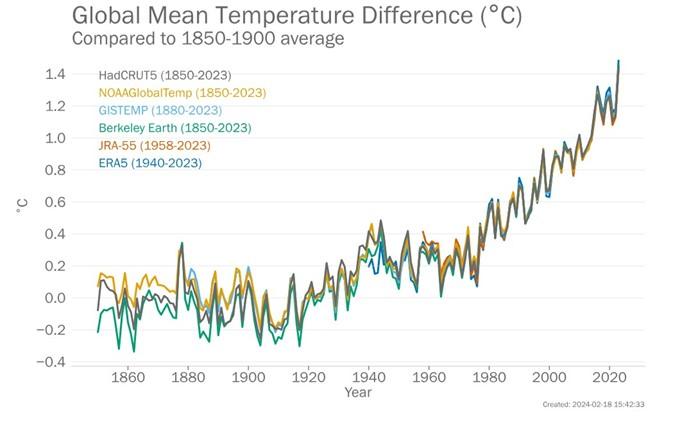
Global map showing the highest Marine Heatwave category in each pixel over 2023 (reference period 1982–2011).
Geneva: A new report from the World Meteorological Organization (WMO) confirmed that 2023 was the warmest year on record in the 174-year observational record, with the global average near-surface temperature at 1.45 °Celsius (with a margin of uncertainty of ± 0.12 °C) above the pre-industrial baseline. It was the warmest ten-year period on record.
Ocean heat content reached its highest level in 2023, according to a consolidated analysis of data. Warming rates show a particularly strong increase in the past two decades. It is expected that warming will continue – a change which is irreversible on scales of hundreds to thousands of years, according to the WMO State of the Global Climate 2023 report.
The report shows that records were once again broken, and in some cases smashed, for greenhouse gas levels, surface temperatures, ocean heat and acidification, sea level rise, Antarctic sea ice cover and glacier retreat.
Heatwaves, floods, droughts, wildfires and rapidly intensifying tropical cyclones caused misery and mayhem, upending everyday life for millions and inflicting many billions of dollars in economic losses.
Observed concentrations of the three main greenhouse gases – carbon dioxide, methane, and nitrous oxide – reached record levels in 2022. Real-time data from specific locations show a continued increase in 2023. CO2 levels are 50 % higher than the pre-industrial era, trapping heat in the atmosphere. The long lifetime of CO2 means that temperatures will continue to rise for many years to come.
Key messages
- State of Global Climate report confirms 2023 as hottest year on record by clear margin
- Records broken for ocean heat, sea level rise, Antarctic sea ice loss and glacier retreat
- Extreme weather undermines socio-economic development
- Renewable energy transition provides hope
- Cost of climate inaction is higher than cost of climate action
“Sirens are blaring across all major indicators… Some records aren’t just chart-topping, they’re chart-busting. And changesare speeding-up.” said United Nations Secretary-General António Guterres.
The global ocean experienced an average daily marine heatwave coverage of 32%, well above the previous record of 23% in 2016. At the end of 2023, most of the global ocean between 20° S and 20° N had been in heatwave conditions since early November 2023.
Of particular note were the widespread marine heatwaves in the North Atlantic which began in the Northern Hemisphere spring, peaked in extent in September and persisted through to the end of the year. The end of 2023 saw a broad band of severe and extreme marine heatwave across the North Atlantic, with temperatures 3 °C above average.
The Mediterranean Sea experienced near complete coverage of strong and severe marine heatwaves for the twelfth consecutive year. Ocean acidification has increased as a result of absorbing carbon dioxide.
“Never have we been so close – albeit on a temporary basis at the moment – to the 1.5° C lower limit of the Paris Agreement on climate change,” said WMO Secretary-General Celeste Saulo. “The WMO community is sounding the Red Alert to the world.”
“Climate change is about much more than temperatures. What we witnessed in 2023, especially with the unprecedented ocean warmth, glacier retreat and Antarctic sea ice loss, is cause for particular concern,” she said.
In 2023, the global mean sea level reached a record high in the satellite record (since 1993), reflecting continued ocean warming (thermal expansion) as well as the melting of glaciers and ice sheets. The rate of global mean sea level rise in the past ten years (2014–2023) is more than twice the rate of sea level rise in the first decade of the satellite record (1993–2002).
On an average day in 2023, nearly one-third of the global ocean was gripped by a marine heatwave, harming vital ecosystems and food systems. Towards the end of 2023, over 90% of the ocean had experienced heatwave conditions at some point during the year.
The global set of reference glaciers suffered the largest loss of ice on record (since 1950), driven by extreme melt in both western North America and Europe, according to preliminary data.
Antarctic sea ice extent was by far the lowest on record, with the maximum extent at the end of winter at 1 million km2 below the previous record year – equivalent to the size of France and Germany combined.“The climate crisis is THE defining challenge that humanity faces and is closely intertwined with the inequality crisis – as witnessed by growing food insecurity and population displacement, and biodiversity loss” said Celeste Saulo.

The number of people who are acutely food insecure worldwide has more than doubled, from 149 million people before the COVID-19 pandemic to 333 million people in 2023 (in 78 monitored countries by the World Food Programme). Weather and climate extremes may not be the root cause, but they are aggravating factors, according to the report.
Weather hazards continued to trigger displacement in 2023, showing how climate shocks undermine resilience and create new protection risks among the most vulnerable populations.
“The latest WMO report is a chilling reminder of runaway climate change and its impacts, including on food insecurity. Reversing this trend will require major investments in solutions that can help countries and communities build resilience to a changing climate, reduce record-breaking emissions and protect lives and livelihoods all at once. Nowhere are these solutions more abundant and impactful than in agriculture and food systems”, said Kaveh Zahedi, Director of the FAO Office of Climate Change, Biodiversity and Environment.
– global bihari bureau





